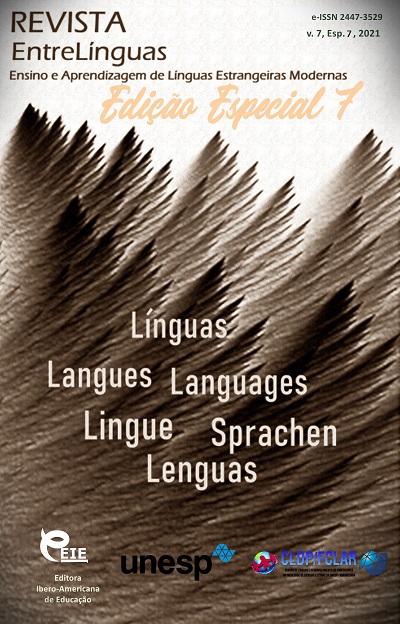O turismo internacional como uma forma substancial de interação língua e comunicação intercultural
DOI:
https://doi.org/10.29051/el.v7iesp.7.16268Palavras-chave:
Comunicação intercultural, Turismo, Globalização cultural, Língua inglesaResumo
O artigo tenta principalmente investigar as questões do turismo intercultural e o papel da língua inglesa como o principal meio de comunicação internacional. Para cumprir o objetivo do estudo, os métodos de pesquisa incluem a análise teórica de atos internacionais, nacionais, regionais e locais, bem como uma análise comparativa da interação de língua estrangeira e russa e turismo. O artigo discute questões relacionadas ao intercâmbio cultural internacional, bem como processos que afetam o desenvolvimento da comunicação intercultural no contexto da globalização do turismo. O artigo revela a importância da comunicação intercultural para as atividades turísticas internacionais e descreve os principais rumos da educação profissional em turismo. Os autores analisaram o desenvolvimento de oportunidades de turismo na República do Tartaristão (Rússia). Com base nos resultados, os materiais do artigo são úteis para especialistas da indústria do turismo, professores de instituições de ensino e uma ampla gama de leitores.
Downloads
Referências
(2003). UNESCO’s General Conference. 32nd Session– Paris, 29 September 17 October.
Abusyarova, D., & Takhtarova, S. (2016). Conflict communication: linguoecological aspect. Journal of Organizational Culture, Communications and Conflict. Volume 20, Special Issue 2 / Ed.Courtney R. Kernek, Southeastern Oklahoma State University. - Jordan Whitney Enterprises, Inc., USA, 154- 158.Alexandrova, A.Yu. (2016). Economics and territorial organization of international tourism. Moscow.
Cultural Heritage and Tourism Development. (2001). Madrid: WTO. International Convention to Safeguard Intangible Cultural Heritage.
Davydenko, L.G. (2013). Positive and negative factors of the impact of globalization on tourism activities. Intercultural communication and tourism in the modern multicultural world community: a collective monograph. -Pyatigorsk: Publishing House of PSLU.
Kondrateva, I.G., & Fakhrutdinova, A.V. (2016). Modeling Teacher's Multicultural Identity through Studying a Foreign Language. Proceedings of IFTE 2016 - 2nd International Forum on Teacher Education. - Vol.12, 245-250. https://doi.org/10.15405/epsbs.2016.07.39
Kyrylov, Y., Hranovska, V., Boiko, V., Kwilinski, A., & Boiko, L. (2020). International Tourism Development in the Context of Increasing Globalization Risks: On the Example of Ukraine’s Integration into the Global Tourism Industry. Journal of Risk and Financial Management, 13(12), 303. https://doi.org/10.3390/jrfm13120303
Resolution (2009). A / KE8 / 406 (XIII) 13 WTO General Assembly, Santiago, Chile, Sept. 27. https: //www.world-tourism.org.
Rosselló, J., Becken, S., & Santana-Gallego, M. (2020). The effects of natural disasters on international tourism: A global analysis. Tourism management, 79, 104080. https://doi.org/10.1016/j.tourman.2020.104080
Smokotin, V.M. (2011). The language of world communication and ethnocultural identity: complementarity in the context of globalization. Tomsk.
The State Committee for Tourism of the Republic of Tatarstan. http://tourism.tatarstan.ru/
Zhang, S., & Liu, X. (2019). The roles of international tourism and renewable energy in environment: new evidence from Asian countries. Renewable energy, 139, 385-394. https://doi.org/10.1016/j.renene.2019.02.046
Downloads
Publicado
Como Citar
Edição
Seção
Licença

Este trabalho está licenciado sob uma licença Creative Commons Attribution-NonCommercial-ShareAlike 4.0 International License.
Os manuscritos aceitos e publicados são de propriedade da Revista EntreLínguas. Os artigos publicados e as referências citadas na Revista EntreLínguas são de inteira responsabilidade de seus autores.
Transferência de direitos autorais – autorização para publicação
Caso o artigo submetido seja aprovado para publicação, já fica acordado que o(s) autor(es) autoriza(m) a UNESP a reproduzi-lo e publicá-lo na EntreLínguas, entendendo-se os termos “reprodução” e “publicação” conforme definição respectivamente dos incisos VI e I do artigo 5° da Lei 9610/98. O artigo poderá ser acessado pela rede mundial de computadores (Internet), sendo permitidas, a título gratuito, a consulta e a reprodução de exemplar do artigo para uso próprio de quem a consulta, desde que haja a citação ao texto consultado. Essa autorização de publicação 328 EntreLínguas, Araraquara, v. 1, n .2, p. 323-328, jul./dez. 2015 não tem limitação de tempo, ficando a UNESP responsável pela manutenção da identificação do(s) autor(es) do artigo. Os artigos publicados e as referências citadas na Revista EntreLínguas são de inteira responsabilidade de seus autores.











